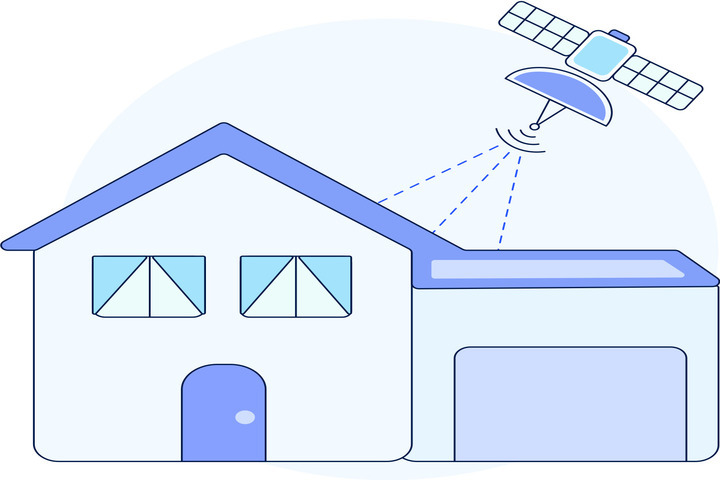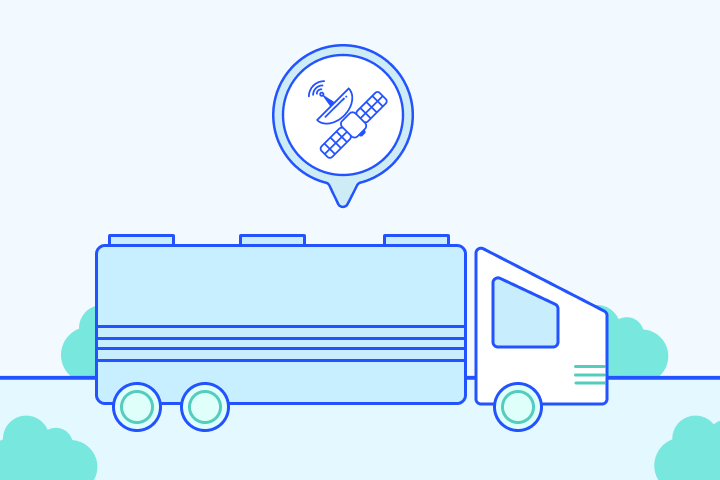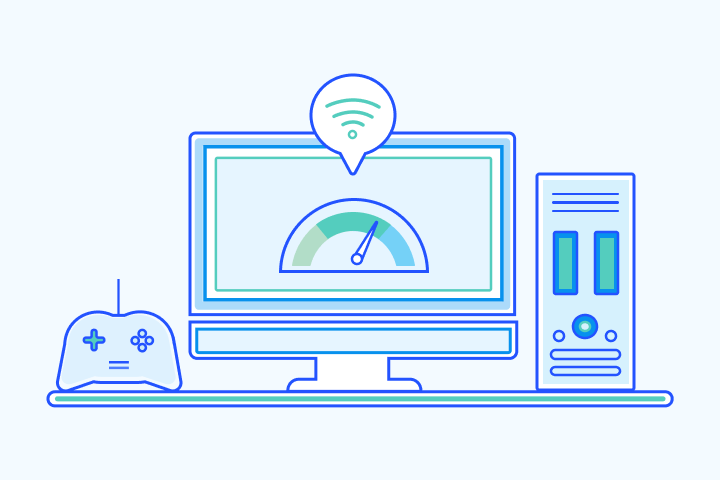Does Weather Affect Satellite Internet?

HighSpeedOptions prides itself on providing honest, quality content. While we may be compensated when you make a purchase through links on our site, all opinions are our own. Here's how we make money.
Table of Contents
Yes, weather does affect satellite internet, especially rain and snow. The impact varies by provider and satellite frequency (Ka vs. Ku-band). Some are prone to experiencing connection issues during unfavorable weather conditions compared to other types of internet providers. Read on to understand how weather can impact your satellite internet connection, what to do during storms, and which satellite services are susceptible to weather.
Key Takeaways: Weather’s Effect on Satellite Internet
- Yes, weather affects satellite internet — rain, snow, and wind can weaken signals, slow speeds, or cause temporary outages.
- Ka-band (HughesNet, Viasat) delivers faster speeds but is more sensitive to rain fade, often requiring additional signal buffer during storms.
- Ku-band (Starlink) holds up better in bad weather due to longer wavelengths, though it offers slightly less bandwidth overall.
- LEO satellites (Starlink, Kuiper) are closer to Earth, so their signals travel shorter distances and experience fewer weather-related interruptions than GEO systems.
- You can reduce slowdowns by rebooting your router, moving closer to it, clearing your dish after storms, upgrading equipment, or using a backup power supply/hotspot.
- Provider choice matters: If you live in a storm-prone region, Ku-band or LEO services may deliver more reliable performance.
Satellite Internet in Stormy Weather: What to Expect
What makes satellite internet so widely available–its ability to beam signals through the sky–is also what makes it vulnerable when the weather turns bad. Because the signal has to travel through layers of atmosphere, rain, snow, and even heavy winds can scatter or weaken it, you can expect to have slower speeds or dropped connections.
It’s not just the weather over your house that matters, either. If severe storms hit the area where your provider’s ground station beams up to the satellite, your service can still be affected—even on a clear day at home.
Another factor is the frequency band your service uses. HughesNet and Viasat use the Ka-band, which offers faster speeds but is more vulnerable to rain and clouds. The Ku-band, used heavily by Starlink internet, holds up better in bad weather due to its longer wavelengths. Ka-band requires two to three times more rain-fade buffer (signal loss when rain absorbs satellite frequencies), so speeds will drop during rain and snowstorms.
- Satellite internet
- 2-year fixed pricing
- No hard data caps
- Fast satellite internet
- Ideal for rural areas
- Up to 3x faster than DSL*
That’s part of why newer LEO (low-Earth orbit) satellites—like Starlink and soon Amazon’s Kuiper—often perform better in storms. LEO satellites are closer, so signals are stronger and travel faster. Combined with frequencies that resist weather interference, this makes them less likely to cut out during storms than GEO satellites.
Ka-Band vs. Ku-Band: What It Means for You
- Ka-Band (HughesNet, Viasat)
- Pro: Higher speeds available
- Con: More sensitive to rain and clouds, which can cause signal dropouts
- Ku-Band (Starlink, some others)
- Pro: Holds up better in bad weather
- Con: Slightly less bandwidth than Ka-band overall
Takeaway: If you live in an area with frequent heavy rain or snow, a Ku-band service like Starlink may deliver more reliable performance. If weather is less of a concern, Ka-band providers still offer competitive speeds and wide coverage, and lower prices.
- High-speed satellite internet
- Low-latency connection
- No annual contracts
How Can You Improve Your Connection During Storms?
Even though severe weather can affect your satellite internet connection, there are always a few steps you can take to shore it up during a storm.
1. Restart Your Router
Often, the simplest fix is the most effective. Restarting your router clears congestion and helps it run smoothly, regardless of internet connection type. Check your provider’s instructions for the proper method, and allow about ten minutes for a full reboot. For prevention, restart it monthly and set a reminder so you don’t forget.
Pro Tip: Keep your router firmware updated. Many updates improve stability and speed.
2. Move Closer to the Router
Wi-Fi speed drops the farther you are from the router. During storms, stay close to it or plug in with an Ethernet cable if possible. Walls and furniture also weaken signals, so consider adding Wi-Fi extenders to boost coverage throughout your home.
Pro Tip: Place your router on a shelf or table rather than the floor to reduce interference.
3. Upgrade Your Equipment or Internet Plan
If weather disruptions are frequent, upgrading to a faster plan gives you more “headroom” during storms. Newer equipment—especially modern satellite dishes or switching to LEO systems like Starlink—can also improve reliability.
Pro Tip: Ask your provider about dish upgrades. Newer Ka- and Ku-band dishes often handle severe weather better than older models.
4. Keep Your Satellite Dish Clear
Your dish needs a clear view of the sky. Safely remove snow, ice, or debris after a storm, and check it regularly for buildup. Even small obstructions can reduce performance.
Pro Tip: Clear snow off your dish only when it’s safe. Even a small layer of buildup can slow speeds.
5. Backup Power Supply
Storms often knock out power grids. Using a battery backup (UPS) for your modem and router keeps you online during temporary outages. After severe weather, inspect your dish for damage or misalignment and contact your provider if speeds don’t return to normal.
Pro Tip: Keep a mobile hotspot (4G/5G) handy as a backup connection during extended outages.
After the storm has passed and it’s safe to do so, inspect your satellite dish for damage. Clear any accumulated debris. If you notice degraded performance after clearing it, then the dish may be out of alignment. Contact your satellite internet service provider to have it properly realigned.
Weatherproofing Your Satellite Internet
Satellite internet is more sensitive to weather than other connection types, but you don’t have to accept constant slowdowns or outages. Simple steps—like keeping your dish clear, rebooting your router, and upgrading your equipment—can make a big difference in performance. And with newer LEO options like Starlink and soon Amazon’s Kuiper, you have access to reliable satellite internet during challenging weather. If you rely on satellite internet in storm-prone areas, compare providers carefully and consider backup options like power supplies and mobile hotspots. You can also prevent satellite internet connectivity issues with simple, regular maintenance steps.
Inclement Weather and Satellite Internet FAQs
Yes. Both use Ka-band signals, which are more vulnerable to storms. HughesNet notes that heavy clouds, local storms, or even weather at distant ground hubs can disrupt service. Viasat usually holds steady in light rain or snow but may cut out during severe storms. If you live in a storm-prone area, weigh reliability carefully before choosing a provider.
Not directly. Wi-Fi inside your home isn’t affected by rain or snow, but if your internet service (like satellite) slows down during storms, your Wi-Fi will be slower too.
Yes. Satellite internet is most affected because signals travel through the atmosphere. Heavy rain, snow, or storms can weaken or block the signal, leading to slower speeds or temporary outages. Cable, fiber, and DSL are generally less impacted.
Satellite internet usually works in light rain or snow, but severe weather can cause interruptions. Ka-band systems (HughesNet, Viasat) are more sensitive to storms, while Ku-band and LEO providers (Starlink) hold up better.
Yes, especially for satellite connections. Rain fade (frequency absorption by rain and snow) and cloud cover can lower speeds by weakening the signal. With fiber internet or cable, your speeds are less likely to change in bad weather unless there’s a power outage.
Starlink (Ku-band, low-Earth orbit) generally performs better in storms than traditional Ka-band services like HughesNet and Viasat. However, no satellite service is completely immune to heavy rain or snow.
Satellite internet signals travel through the atmosphere, and rain, snow, and thick clouds absorb or scatter those signals. This is called “rain fade,” and it’s especially strong in higher frequencies like Ka-band.
Find providers in your area

Table of Contents








